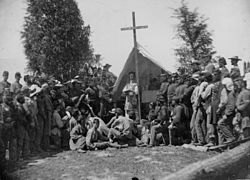Fort Corcoran
| Fort Corcoran | |
|---|---|
| Part of the Civil War defenses of Washington, D.C. | |
| Arlington, Virginia | |

The Fighting 69th; Irish Brigade, New York Volunteer Regiment, United States attend church services at Fort Corcoran in 1861.
|
|
| Coordinates | 38°53′46″N 77°04′33″W / 38.896111°N 77.075833°W |
Fort Corcoran was a wood-and-earthwork fortification constructed by the Union Army in northern Virginia as part of the defenses of Washington, D.C. during the American Civil War. Built in 1861, shortly after the occupation of Arlington, Virginia by Union forces, it protected the southern end of the Aqueduct Bridge and overlooked the Potomac River and Theodore Roosevelt Island, known as Mason's Island.
The fort was named after Colonel Michael Corcoran, commander of the U.S. Fighting 69th Infantry, Irish Brigade 69th New York Volunteer Regiment, one of the units that constructed the fort. Fort Corcoran was home to the Union Army Balloon Corps and the headquarters of the defenses of Washington south of the Potomac River, and served throughout the war before being dismantled in 1866. Today, no trace of the fort remains, though a small historical marker has been erected by the Arlington Historical Society.
Before the outbreak of the Civil War, Alexandria County (renamed Arlington County in 1920), the closest Virginia county to Washington, D.C., was a predominantly rural area. Originally part of the District of Columbia, the land now comprising the county was retroceded to Virginia in a July 9, 1846 act of Congress that took effect in 1847. Most of the county is hilly, and at the time, most of the county's population was concentrated in the city of Alexandria, at the far southeastern corner of the county. In 1861, the rest of the county largely consisted of scattered farms, the occasional house, fields for grazing livestock, and Arlington House, owned by Mary Custis, wife of Robert E. Lee.
...
Wikipedia

